Creating a Home Safety Plan for Seniors

By Jennifer Footit-Tank, quality care coordinator at Network Health
You may have heard the phrase “aging in place.” The Centers for Disease Control and Prevention (CDC) defines this as “the ability to live in one’s own home and community safely, independently and comfortably, regardless of age, income or ability level.” This is achievable but does come with the need for planning.
You can plan this yourself, work with your family or hire a professional. If you have concerns with being safe while living at home, putting together a plan and taking advantage of available resources will help you to feel more secure. Here is some at-home safety guidance to help you get started on your home safety plan.
Fall Prevention Steps
Falls are a major concern for seniors who live at home. Most falls occur while walking in your home from your bedroom to the bathroom. The longer a person is on the floor, the harder it will be to recover your independence. Many people do not put in prevention measures until they have experienced at least one fall.
Fall proofing your home is the most proactive way to stay safe. Use a home safety checklist to see if you need to complete simple home modifications. Some great places to start include bright lighting inside and outside of the home, open walkways in each room, no rugs on the floor, handrails on the stairways and grab bars in the bathroom.
How Seniors Can Get Help in an Emergency
How do you call for help should you need it? There are several options available that are both high and low tech.
Medical alert system – These are usually a necklace or bracelet that allows you to push a button which connects you to a live person who can send emergency services to your home. Some versions can detect when you fall or if you are in your yard. There is usually a monthly fee for this service.
Voice activated smart device – Many homes now have these devices throughout the home. You can set it up to call a family member, friend or neighbor when given the verbal command. Some devices can even call emergency services for you. This will provide you with 24/7 emergency availability when needed.
[Read more: Get Help Setting Up Your Smartphone and More Tips In Case You Fall Down]
People you know – Ask family or friends to check in with you at a specific time either by phone or in person every day. This daily contact is a great way to stay connected and have a safety check.
Signal – Working with a neighbor, you could establish a signal that says you are up for the day or ready for bed. This could be a shade pulled up or down in a specific window or a light turned on or off. The purpose of a consistent signal is to alert your neighbors that something may be wrong if they don’t see the signal.
Cell phone or smart watch – Always carry a fully charged cell phone or smart watch with you. When it needs to charge, make sure it is within reach or that you have a land line you can use.
Available Resources for Fall Prevention and Home Safety
Contact your county’s Aging and Disability Resource Center (ADRC) to see what programs or information you may be eligible to receive. This resource is a one-stop-shop for any questions or resources you may be looking for.
The Centers for Disease Control and Prevention (CDC) offer free resources through their STEADI older adult fall prevention patient education program. For more information, call 800-232-4636 or 888-232-6348 (TTY). You can also visit www.cdc.gov/steadi/index.html.
The National Council on Aging is a nonprofit organization promoting resources available to help you prevent falls. You can visit their website for more information.
Veterans Affairs sometimes offers resources to veterans in your area. Call 877-222-8387 or visit VA.gov.
Being at home is where you feel safe and comfortable. Working with family or friends and using available resources, you can build a safety plan that fits your individual needs.



